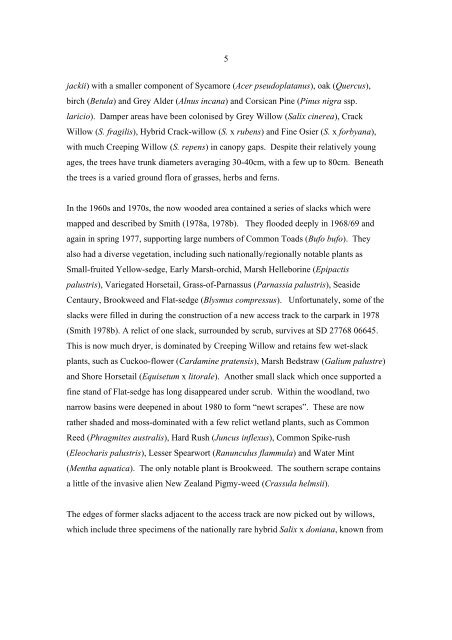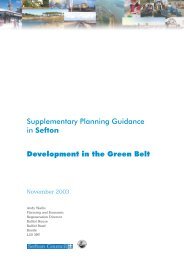The impact of sand extraction at Formby Point ... - Sefton Council
The impact of sand extraction at Formby Point ... - Sefton Council
The impact of sand extraction at Formby Point ... - Sefton Council
Create successful ePaper yourself
Turn your PDF publications into a flip-book with our unique Google optimized e-Paper software.
5<br />
jackii) with a smaller component <strong>of</strong> Sycamore (Acer pseudopl<strong>at</strong>anus), oak (Quercus),<br />
birch (Betula) and Grey Alder (Alnus incana) and Corsican Pine (Pinus nigra ssp.<br />
laricio). Damper areas have been colonised by Grey Willow (Salix cinerea), Crack<br />
Willow (S. fragilis), Hybrid Crack-willow (S. x rubens) and Fine Osier (S. x forbyana),<br />
with much Creeping Willow (S. repens) in canopy gaps. Despite their rel<strong>at</strong>ively young<br />
ages, the trees have trunk diameters averaging 30-40cm, with a few up to 80cm. Bene<strong>at</strong>h<br />
the trees is a varied ground flora <strong>of</strong> grasses, herbs and ferns.<br />
In the 1960s and 1970s, the now wooded area contained a series <strong>of</strong> slacks which were<br />
mapped and described by Smith (1978a, 1978b). <strong>The</strong>y flooded deeply in 1968/69 and<br />
again in spring 1977, supporting large numbers <strong>of</strong> Common Toads (Bufo bufo). <strong>The</strong>y<br />
also had a diverse veget<strong>at</strong>ion, including such n<strong>at</strong>ionally/regionally notable plants as<br />
Small-fruited Yellow-sedge, Early Marsh-orchid, Marsh Helleborine (Epipactis<br />
palustris), Varieg<strong>at</strong>ed Horsetail, Grass-<strong>of</strong>-Parnassus (Parnassia palustris), Seaside<br />
Centaury, Brookweed and Fl<strong>at</strong>-sedge (Blysmus compressus). Unfortun<strong>at</strong>ely, some <strong>of</strong> the<br />
slacks were filled in during the construction <strong>of</strong> a new access track to the carpark in 1978<br />
(Smith 1978b). A relict <strong>of</strong> one slack, surrounded by scrub, survives <strong>at</strong> SD 27768 06645.<br />
This is now much dryer, is domin<strong>at</strong>ed by Creeping Willow and retains few wet-slack<br />
plants, such as Cuckoo-flower (Cardamine pr<strong>at</strong>ensis), Marsh Bedstraw (Galium palustre)<br />
and Shore Horsetail (Equisetum x litorale). Another small slack which once supported a<br />
fine stand <strong>of</strong> Fl<strong>at</strong>-sedge has long disappeared under scrub. Within the woodland, two<br />
narrow basins were deepened in about 1980 to form “newt scrapes”. <strong>The</strong>se are now<br />
r<strong>at</strong>her shaded and moss-domin<strong>at</strong>ed with a few relict wetland plants, such as Common<br />
Reed (Phragmites australis), Hard Rush (Juncus inflexus), Common Spike-rush<br />
(Eleocharis palustris), Lesser Spearwort (Ranunculus flammula) and W<strong>at</strong>er Mint<br />
(Mentha aqu<strong>at</strong>ica). <strong>The</strong> only notable plant is Brookweed. <strong>The</strong> southern scrape contains<br />
a little <strong>of</strong> the invasive alien New Zealand Pigmy-weed (Crassula helmsii).<br />
<strong>The</strong> edges <strong>of</strong> former slacks adjacent to the access track are now picked out by willows,<br />
which include three specimens <strong>of</strong> the n<strong>at</strong>ionally rare hybrid Salix x doniana, known from















